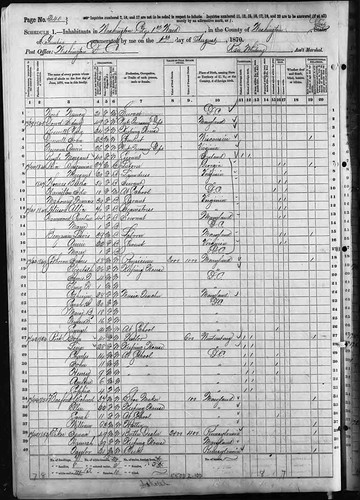Thoughts about the Census projections for DC
Steve Morris writes:
You said in your testimony on the DC Main Streets program that "people are moving back to the city in droves." Capitol Hill seems to be growing with lots of new housing and apts. The Mayor agrees, but the Census numbers show a continuation of the city's declining population. What's your take on it? (This was first reported in "U.S. Census Bureau Foresees A Diminished District in 2030" in the Washington Post.)
 A Census enumeration sheet for Washington County, District of Columbia, 1870. Image from Rootsweb.com.
A Census enumeration sheet for Washington County, District of Columbia, 1870. Image from Rootsweb.com.Richard Layman writes:
I admit that I don't get around to all parts of the city, but the Census projections make no sense to me. (1) There are many new units coming on line and occupied in Downtown, on 14th Street, Adams Morgan, Columbia Heights, Logan Circle, along Massachusetts Avenue NW, and in other places (although the rents seem high to me and I wonder if there will be an overhang of inventory soon) . (2) Many previously vacant houses are being renovated and occupied all over the city. (3) Infill housing is being constructed (e.g., I saw some units being constructed on 32nd St. between P and Q in Georgetown just the other day).
All this seems to add plenty of inventory which implies an increase in population.
But I am not familiar with the ins and outs of far southeast, where in particular many large families have been displaced and replaced with smaller households. Similarly large projects have been redone into a smaller number of total units, leading to big reductions in population for particular housing projects. And in the short run, upwards of a couple thousand people have been displaced at Capper-Carrollsburg, by the rebuilding of this housing project as part of a HOPEVI redesign, etc.
There was an excellent piece about the impact of HOPE VI, the overall reduction of dwelling units for the poorest among us, and displacement to PG County, called "Shouldering the Burden", in the Gazette Newspapers (Maryland counties) in 2003.
Similarly as rented households are converted to owner occupied dwellings, this is often accompanied by a decrease in household size (and an increase in rents, for existing units, as the supply contracts).
I do believe that household sizes are shrinking. But I think the in-migration is high. In short, I have a hard time believing the Census numbers. (And I worked on the 2000 Census.) Perhaps their models must project all center cities shrinking, with the possible exception of Manhattan and Brooklyn. I think Washington is an odd exception overall, partly because of the strength of the core employment center as a driver of demand for in-city housing, but also because the city is small (39 square miles of livable non-federal space) and with an urban design that favors livability, which is attractive as well, further driving demand for living in the center city as opposed to the suburbs.
It's not that other cities aren't growing in parts. E.g., certain neighborhoods in Baltimore, Philly's Center City, the University City District is growing marginally, etc., but overall these cities are still experiencing population declines. DC could be a Paris-like, Manhattan-like exception to the rule.
What do other people think?



0 Comments:
Post a Comment
<< Home